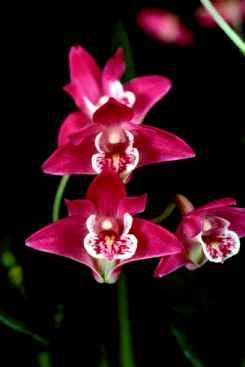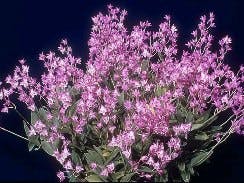
Dendrobium kingianum 'Sparkles' HCC/AOS
Dendrobium kingianum is a very common species in Australia. Recently there has been a proposal to transfer this species and those related to it to a new genus, Thelychiton, although it remains to be seen if this name change will be accepted.
Its habitat ranges from approximately 32° south to 23° north in a crescent shape along the east coast. This 850 km (530 mile) strip is approximately 150 km (95 miles) wide at its widest point and as with many other native species, comes to a halt at the Hunter River. It is almost exclusively a lithophyte with very few plants found as epiphytes. Flowers vary from 15 mm to 40 mm (0.6-1.6 inch) on good line bred clones.
Plants vary from small groups to large colonies to several metres in diameter on north to east facing rock shelf in open forest and along forest creeks. Within this large habitat range is also a diversity of weather patterns. This variation creates obvious clonal differences and flowers vary from white to a purple/red with attractive and equally varied labellum markings in the form of spots and stripes. Some plants are given to more frequent aerial growths (keikis) and in cultivation this can either be a blessing or curse, depending on your requirements. However, in cultivation, aerials (keikis) occur more frequently with over fertilizing in winter and over watering at all times.

Den. kingianum 'Inferno', AM/AOS
Australians usually grow Den. kingianum in squat pots as roots do not travel large distances and a good starting point for a 100 mm (4 inch) pot size is a 50% mixture of bark and river stones of 15 mm (about ½ inch) diameter. Component size will vary from 6 mm -20 mm (1/4-3/4 inch) along with pot size but if in doubt use larger rather than smaller components. Northern hemisphere growers will need to convert these components to provide the good drainage necessary as this species does not like to stay wet for long periods as per their normal habitat. Den. kingianum can comfortably tolerate 70% sunlight at most times, the exception being the hot part of the afternoon. This is of course dependent on local conditions. Australian growers normally use 50% shade cloth and those growing Cymbidiums or perhaps species such as Laelia anceps will easily adapt to growing Den. kingianum. Good airflow is also essential and will tolerate temperatures from freezing to over 40ºC (104F) under these conditions. Each flowering raceme can provide up to 15 flowers and a specimen pot of 200 mm (8 inch) (or greater) is a glorious sight so do not be in a hurry to divide.
A preferred aim is to promote maximum growth over summer and autumn by repotting or dividing as soon as flowering has finished and regular watering. This will achieve early growth and full pseudobulb growth by the end of the warmer period, maximizing light and reducing water as the weather cools in order to harden plants. In winter racemes begin to form when plants show little growth activity. Plants should be watered when dry and watch for pests attacking emerging racemes. This is a very hardy species and does best when left alone after initial basic care has been provided.

Dendrobium kingianum 'Betty' CCM/AOS
The usual array of pests such as mealy bug, scale and aphids attack these plants but northern hemisphere growers are fortunately safe from the dreaded Dendrobium Beetle (Stethopachys formosa), which lays its eggs in newly forming pseudo bulbs of this and many other genera causing the loss of infected growths.
Courtesy of Alan W Stephenson National Conservation Officer, Australasian Native Orchid Society (ANOS) Conservation Director, Australian Orchid Council (AOC)









